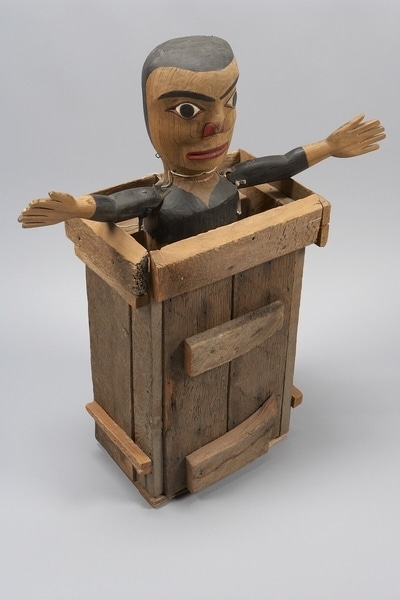Puppet Item Number: A6891 from the MOA: University of British Columbia




Description
Nunlhamgila puppet. Wooden male, articulated figure, in a box. Consisting of various pieces of wood, the rectangular body has two carved arms attached to it with pieces of leather. The head is made from a separate piece and sits on a dowel. He moves by means of two spools of string placed in the back of the box. Attached to the spools are parts of a Buckinghams cigarettes box; one has ‘rite hand’ written, the other ‘left hand’. The chest and arms of the man are painted black, the head is black. The face has black brow, large black eyes on a white background while the nose and lips are painted red. The puppet is mounted in a rectangular shaped, cedar box with a rim.
History Of Use
These articulated characters are known as dług̱we’ treasures (as are the theatrical dances in which they appear). The Kwakwaka’wakw have history of puppetry related to ceremonial feasts. The winter potlatches are known for their spectacular performances, suffused with cultural teachings and supernatural content, such as the coming of Winalagalis, the supernatural warrior. Dances and songs associated with Winalagalis include the tuxw’id, which is performed by women who have the power and rights to make the dług̱we’ treasures (puppets) come to life. The box would have been buried in the dirt floor of the bighouse, with only the head showing. During a ceremonial event, the tuxw’id performer could make the human-like figure pop-up from the box, positioned in the centre of the bighouse, to the surprise and delight of those who were there to witness the event.
Iconographic Meaning
Represents Nunlhamgila: the fool-maker.
Narrative
The puppet belonged to Emily Watson, who said in her 1958 letter to MOA that she, herself, had performed with the pupppet.
Item History
- Made in British Columbia, Canada before 1958
- Collected in Kingcome Inlet, British Columbia, Canada and Ukwanalis, British Columbia, Canada
- Owned by Emily Watson before May 27, 1958
- Received from Leon & Thea Koerner Foundation (Funding source) and Emily Watson (Seller) on May 27, 1958
What
Who
- Culture
- Kwakwaka'wakw
- Previous Owner
- Emily Watson
- Received from
- Leon & Thea Koerner Foundation (Funding source) and Emily Watson (Seller)
Where
- Holding Institution
- MOA: University of British Columbia
- Made in
- British Columbia, Canada
- Collected in
- Kingcome Inlet, British Columbia, Canada and Ukwanalis, British Columbia, Canada
When
- Creation Date
- before 1958
- Ownership Date
- before May 27, 1958
- Acquisition Date
- on May 27, 1958
Other
- Condition
- fair
- Current Location
- Case 24
- Accession Number
- 2312/0001